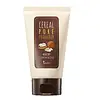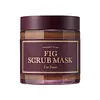What's inside
What's inside
 Key Ingredients
Key Ingredients

 Benefits
Benefits

 Concerns
Concerns

 Ingredients Side-by-side
Ingredients Side-by-side

Oryza Sativa Bran Extract
Skin ConditioningOryza Sativa Bran
AbrasiveGlycerin
HumectantStearic Acid
CleansingLauric Acid
CleansingPotassium Hydroxide
BufferingMyristic Acid
CleansingCocamidopropyl Betaine
CleansingPotassium Cocoyl Glycinate
Juglans Regia Shell Powder
AbrasiveJuglans Regia Seed Extract
Skin ConditioningCastanea Crenata Shell Extract
Skin ConditioningPerilla Ocymoides Seed Extract
AntioxidantLens Esculenta Seed Extract
Skin ProtectingPEG-40 Hydrogenated Castor Oil PCA Isostearate
Skin ConditioningPEG-32
HumectantInulin Lauryl Carbamate
Emulsion StabilisingGlyceryl Stearate
EmollientPEG-100 Stearate
Polyquaternium-7
Water
Skin ConditioningPhenoxyethanol
PreservativeDisodium EDTA
Parfum
MaskingOryza Sativa Bran Extract, Oryza Sativa Bran, Glycerin, Stearic Acid, Lauric Acid, Potassium Hydroxide, Myristic Acid, Cocamidopropyl Betaine, Potassium Cocoyl Glycinate, Juglans Regia Shell Powder, Juglans Regia Seed Extract, Castanea Crenata Shell Extract, Perilla Ocymoides Seed Extract, Lens Esculenta Seed Extract, PEG-40 Hydrogenated Castor Oil PCA Isostearate, PEG-32, Inulin Lauryl Carbamate, Glyceryl Stearate, PEG-100 Stearate, Polyquaternium-7, Water, Phenoxyethanol, Disodium EDTA, Parfum
 Reviews
Reviews

Ingredients Explained
These ingredients are found in both products.
Ingredients higher up in an ingredient list are typically present in a larger amount.
You might know this ingredient as walnut shell powder. It is an abrasive used as a physical exfoliator.
Abrasives are physical exfoliants used to get rid of dead cell buildup on your skin. Physical exfoliators have a bad reputation due to the myth that they give your face tiny cuts. This is untrue.
Like any exfoliant, using this ingredient can disrupt your skin barrier. This can lead to breakouts, irritation, and dryness. It is critical to be gentle when using any type of exfoliator.
If you want to use a chemical exfoliator instead, check out glycolic acid.
Learn more about Juglans Regia Shell PowderParfum is a catch-all term for an ingredient or more that is used to give a scent to products.
Also called "fragrance", this ingredient can be a blend of hundreds of chemicals or plant oils. This means every product with "fragrance" or "parfum" in the ingredients list is a different mixture.
For instance, Habanolide is a proprietary trade name for a specific aroma chemical. When used as a fragrance ingredient in cosmetics, most aroma chemicals fall under the broad labeling category of “FRAGRANCE” or “PARFUM” according to EU and US regulations.
The term 'parfum' or 'fragrance' is not regulated in many countries. In many cases, it is up to the brand to define this term.
For instance, many brands choose to label themselves as "fragrance-free" because they are not using synthetic fragrances. However, their products may still contain ingredients such as essential oils that are considered a fragrance by INCI standards.
One example is Calendula flower extract. Calendula is an essential oil that still imparts a scent or 'fragrance'.
Depending on the blend, the ingredients in the mixture can cause allergies and sensitivities on the skin. Some ingredients that are known EU allergens include linalool and citronellol.
Parfum can also be used to mask or cover an unpleasant scent.
The bottom line is: not all fragrances/parfum/ingredients are created equally. If you are worried about fragrances, we recommend taking a closer look at an ingredient. And of course, we always recommend speaking with a professional.
Learn more about Parfum